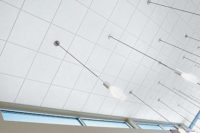Imagine being able to tell, in a matter of seconds, how much alcohol the bartender put into that margarita you ordered, your body’s water content (hydration), or the amount of fat in that fast food meal you just consumed—with a device small enough to be on a keychain. Science fiction? Not for a couple of upstart, crowd-funded companies, TellSpec and SCiO, both about to release similar devices which will allow you “to get instant relevant information about the chemical make-up of just about anything around you, sent directly to your smartphone” for the low, low price of $249.
These tiny devices use something called Near Infrared (NIR) Spectroscopy, used in science labs for decades, to identify the molecular makeup of anything and everything. While the technology is not new, availability to the public has been almost non-existent due to the cost and size of the equipment required to conduct NIR spectroscopy analysis. TellSpec and SCiO have both come up with an idea that changes that—by miniaturizing the device used to zap samples with the proper light spectrum and a cloud-based analytical method involving math and algorithms. Both companies claim that anyone can use the devices on just about anything to find out what stuff is made of.
TellSpec is introducing their device initially to detect only “calories, macronutrients, ingredients, some chemicals and some allergens” in simple foods. TellSpec will initially report the top six USDA allergens of gluten, milk, peanuts, tree nuts, seafood and eggs. It will not detect trace amounts of these allergens, or of any other ingredient or chemical. As the company gains experience and refines its analytical process, more ingredients and allergens may be added to the database. Consumer Physics SCiO, in addition to analyzing food, will also allow users to scan things identified by the company as not tested but highly feasible such as plastics, fibers, water pollutants, and minerals, and growing the database. The more things scanned, the bigger and more accurate the database becomes.
Building Industry Applications
My immediate thought when I learned about these slick little devices was that the transparency-in-materials crowd could use them to scan building materials for chemicals of concern. The scanners, however, are not accurate enough to be able to identify ingredients that represent less than 1 percent of the total makeup of the material or object scanned. So while many chemicals could potentially be identified, anything below the 1 percent threshold would not be. And while ingredients can be identified, things emitted by a material, like VOCs, would be much more difficult for a hand-held scanner to detect and identify.
While building material ingredient scanning applications would provide somewhat limited usefulness, are other applications, perhaps, that offer potentially greater, industry-changing benefits?
Water-to-Cement Ratio in Concrete
Contract documents prepared by design professionals typically require that the water-to-cement ratio in concrete not exceed a specific value. This value is used to determine/predict the strength of the concrete prior to placement. This value is also relied upon by floor covering installers and manufacturers as a key indicator of how much moisture will be in the concrete at the time floor coverings are to be installed over concrete slabs. There are a number of things that can change the water-to-cement ratio, unbeknownst to the designer, including water added to the mix just prior to placement and moisture in the aggregate. High water-to-cement ratios result in weaker concrete and higher moisture content, the latter often resulting in premature floor covering failures. Research has proven that NIR spectroscopy is an accurate way to measure water-to-cement ratios in freshly mixed concrete and there are already NIR devices on the market that can measure moisture content of cured concrete. Until now, however, neither has been widely available or affordable. These devices could change that and provide a readily accessible, easily affordable means to test concrete before and after placement, avoiding the problems associated with too much moisture in the concrete.
Recycled Content of Plastics
Near IR spectroscopy has been used for years to identify types of plastics (and carpet fiber) at recycling facilities, where it is critical that the various plastic streams remain free of incompatible plastic contamination. The equipment used for this is clunky and expensive. Palm-sized scanners at $250 each would allow a building construction and demolition crew to easily and quickly separate plastics and carpet into like bins, making the recycling process more efficient and reducing the possibility of contamination at the recycling plant. Instead of lumping all the plastic and carpet into a bin scheduled for incineration, an all-too-common practice during building demolition and construction, cheap NIR scanners would allow recyclable plastics to be diverted from the incinerator to be recycled into new building materials.
Gas-Filled Insulating Glass Units
As energy codes become more stringent, pressure to reduce glass and increase its energy efficiency is ever rising. One way to meet energy code requirements for glazing performance without sacrificing much in terms of glass area or visible light transmittance is to fill the space between the glazing lites with noble gasses with higher insulating value than air such as argon and krypton. The challenge owners and designers face with this strategy is knowing whether or not the gas made it into the glazing unit and how long it will stay in place. Near IR spectroscopy is one method to check for both. In the paper “A non-invasive method for measuring relative concentration of gases (i.e., argon) in double-pane windows,” the authors conducted a laboratory test using NIR spectroscopy to measure the amount of argon gas in an insulating glass unit and how much argon escaped over a predetermined time frame.
While the laboratory testing was elaborate and complicated, the authors conclude that field-deployable instruments could be used as well. Being able to do so cheaply and quickly with these new hand-held devices would allow owners, contractors and designers to verify the gas content of the glazing units prior to installation and to spot-check units over time to ensure that the gas remains in place in accordance with warranty requirements, saving countless dollars in energy costs.
Conclusion
It may sound like something straight out of StarTrek, but hand-held devices that can identify the content of nearly everything around us will be available very soon. While the TellSpec Web site has not yet established a date of availability, the SCiO can be purchased now for $249, with a promised delivery date of March 2015. In addition to food, these inexpensive little scanners can also be used to evacuate the content of just about anything else—including to find out your car’s fuel grade, identifying a pill from an unknown source, and to track changes in the materials around you—building materials included.






Report Abusive Comment